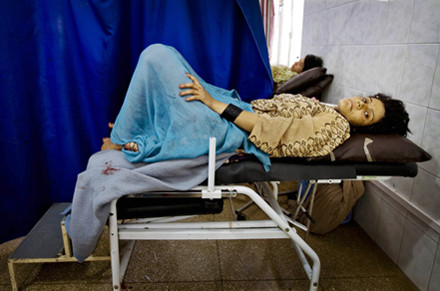By Aunohita Mojumdar
Kabul - Nine years and billions of dollars into the Afghanistan war the US government is eager to show progress.

Afghanistan has the second highest maternal mortality rate in the world. (Photo: Kate Holt/IRIN)
The US government estimates 6 million refugees have returned to the country and some 7 million children are back in school. And then there is the widely cited claim that 85 percent of Afghans that have access to healthcare, as in this recent report from the US Agency for International Development: “USAID and other donors have worked so that now more than 85 percent of the population has access to some form of health care, up from 9 percent in 2002."
There's just one problem, say healthcare officials in Afghanistan. That claim, also peddled by the British government’s aid agency, the World Bank and at times by the Afghan government, isn't true. And healthcare workers say it's created a false sense of accomplishment that's actually undermining efforts to improve health services for Afghans.
Though it's been repeated over and over, it's not hard to see how unlikely it is. If 85 percent of Afghan's did have access to healthcare, Afghanistan would be ahead of every country in the region after three-decades of almost non-stop war.
Both the Afghan government’s Minister of Health as well as the Representative of the World Health Organization (WHO) in Afghanistan say that the claim is misleading. According to the Ministry of Health, which provided the initial data, the claim stems from a misunderstanding of the fact that 85 percent of Afghanistan's districts have at least one basic health facility.
However a district can cover vast tracts of mountainous terrain, leaving district health facilities inaccessible to millions of Afghans.
“It does not mean 85 percent of Afghans have access or easy access or avail themselves of health facilities,” says Peter Graaff, the head of the WHO mission in Afghanistan.
Essentially, that would be akin to saying that just because every state in the US had a hospital, 100 percent of Americans had access to healthcare.
“The coverage of the basic primary health services in Afghanistan falls perilously short of the requirements of the population, leaving millions of Afghans with no or limited access to basic healthcare” read a UN statement Dec. 5, adding that according to its tally, “only 52 percent of the rural population have access to a health facility within one hour walking distance.”
To be sure, accurate healthcare figures are difficult to come by. The National Risk and Vulnerability Assessment carried out by the Afghan government with international support last year is the most accurate sampling of access to healthcare and came up with an estimate of 60 percent access.
Afghanistan’s acting Minister of Health Suraya Dalil insists that continuing to cite the 85 percent as harming efforts to improve health services. “According to the National Risk and Vulnerability Assessment around 60 percent of the population has access to health,” says Dr. Dalil. “I have questioned the 85 percent figure since I came into this office.”
Graaff says he implores aid officials not to use this statistic, “it is not wise to use these figures as a success story,” he says.
The false statistic has prevented adequate attention on the health sector from donors and the Afghan government says Dalil. The Afghan Finance Ministry, which channels much of Afghanistan's development aid, said: “You don’t need the money, you are well off. Donors tell us ‘you are so successful. You have reached 85 percent of the population. You don’t need additional resources,’ ” according to Dalil.
With a $10.92 per capita expenditure on health, Afghanistan is still way below a target of $15 to $30 per capita expenditure recommended by the WHO, especially for a country affected by protracted crisis. Other Afghan health indicators remain dismal.
“Although maternal mortality rates have been reduced from 1,600 deaths for every 100,000 live births in 2002 to 1,400 deaths in 2010, Afghanistan still has the second-highest maternal mortality ratio in the world after Sierra Leone” a joint statement issued by UNICEF, WHO, and UNFPA said at the Geneva Conference on Millennium Development Goals. "The same holds true for soaring infant and child mortality figures, although there has been a slight improvement in these numbers as well.”



